Over 70% of project failures trace back to poor alignment at the very beginning. One team even launched a six-month initiative without realizing two departments had opposing definitions of success.
How to run a project kickoff meeting with clear expectations isn’t just a procedural step; it’s your best shot at avoiding chaos, clarifying ownership, and launching with unstoppable momentum.
In this article, we will explore:
- Run your kickoff meeting using this 8-step clarity blueprint
- Prevent common kickoff failures with these smart fixes
- Nail the 48-hour follow-up that turns planning into progress
Master your project kickoff meeting: The 8-step blueprint for crystal-clear expectations
Running a successful project kickoff meeting is about creating a shared vision that transforms confusion into clarity. When done right, it prevents scope creep, eliminates miscommunication, and ensures every stakeholder knows exactly what's expected.
Here's the proven 8-step framework that delivers exceptional results:
Step 1: Pre-meeting preparation
The foundation of any successful kickoff meeting is built days before anyone enters the room. Think of this phase as laying the groundwork for a construction project; without proper preparation, everything that follows becomes unstable.
- Create a detailed agenda 48-72 hours in advance and distribute it to all attendees
- Share essential documents, including the project charter, scope statement, and preliminary timeline
- Identify and confirm attendance of all key stakeholders and decision-makers
- Assign specific meeting roles such as facilitator, note-taker, and timekeeper
Pro Tip: Send a "pre-read package" with your agenda that includes a one-page project summary. This ensures attendees come prepared, and you can spend meeting time on discussion rather than information delivery. Studies show that meetings with pre-distributed materials are 40% more productive than those without.
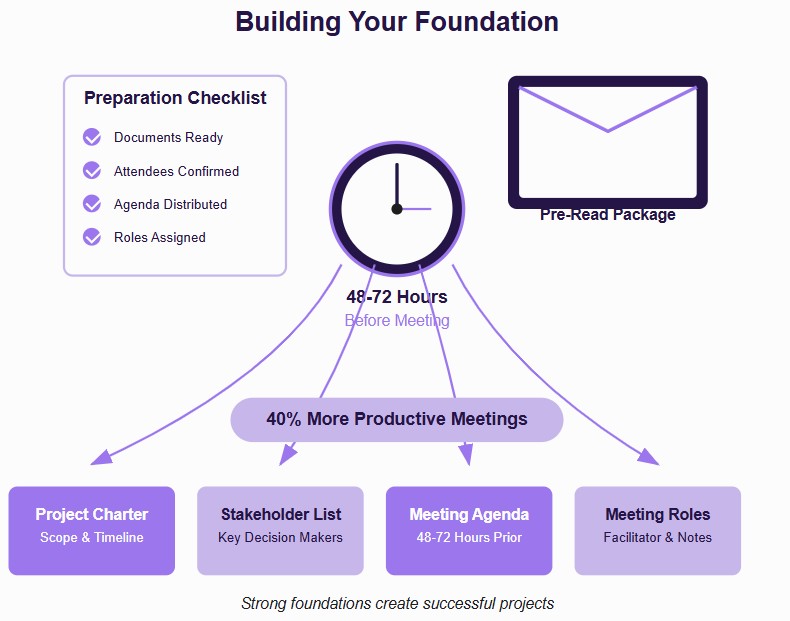
Step 2: Set meeting foundation
The first 10 minutes of your kickoff meeting determine the energy and engagement for the entire session. A strong opening creates psychological safety and establishes the collaborative tone you need for success.
- Welcome attendees warmly and establish clear ground rules for participation
- Review the meeting agenda and confirm everyone understands the objectives
- Facilitate brief introductions or use an icebreaker to energize the group
- State the meeting's purpose explicitly to align everyone's focus
Example Opening: "Welcome, everyone! Over the next 90 minutes, we're going to align on our shared vision for [Project Name], clarify exactly who's responsible for what, and leave with a clear roadmap that sets us all up for success. Let's start by having everyone share their name, role, and one word that describes how they're feeling about this project."
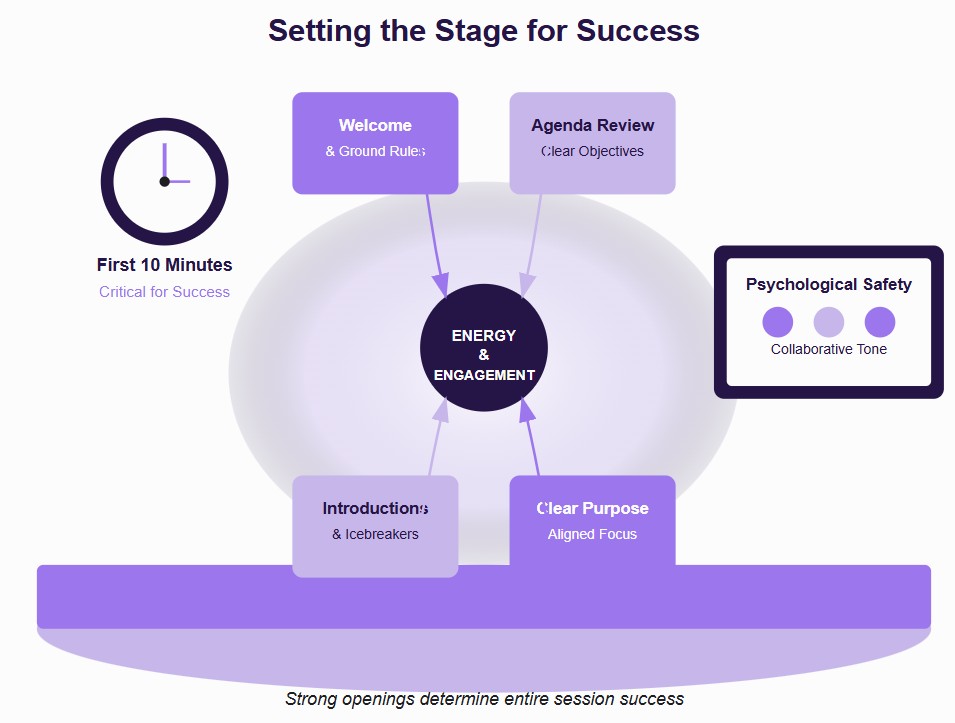
Step 3: Define project vision and purpose
This step answers the most critical question: "Why does this project matter?" Without a compelling vision, team members lack the motivation and context needed to make good decisions throughout the project lifecycle.
- Explain the fundamental "why" behind the project's existence
- Connect project goals directly to broader business objectives and strategy
- Share specific success criteria and key performance indicators
- Demonstrate alignment with company strategic goals and priorities
Real-World Application: Instead of saying "We need to build a new website," try "We're creating a digital experience that will reduce customer support calls by 30% and increase online conversions by 25%, directly supporting our goal to become the market leader in customer satisfaction."

Step 4: Clarify scope and boundaries
Scope creep kills more projects than any other factor, and it starts with unclear boundaries. This step is your insurance policy against endless feature additions and unrealistic expectations.
- Define explicitly what IS included in the project deliverables
- State clearly what is NOT included to prevent future scope creep
- Review all major deliverables and milestone expectations
- Establish the change management process for handling scope modifications
Critical Success Factor: Use the phrase "out of scope" at least three times during this discussion. Make it comfortable for people to hear and use this phrase throughout the project. Successful projects have clear boundaries, and everyone should feel empowered to protect them.
Step 5: Establish roles and responsibilities
Confusion about "who does what" is the fastest way to create project chaos. This step eliminates ambiguity and ensures accountability from day one.
- Present a RACI matrix clearly showing who is Responsible, Accountable, Consulted, and Informed
- Define decision-making authority and approval processes
- Establish escalation procedures for issues and conflicts
- Set clear expectations for team member availability and commitment levels
Pro Tip: Don't just present the RACI matrix; have the team validate it together. Ask "Does everyone agree that Sarah is accountable for the final design approval?" This collaborative validation prevents future finger-pointing and ensures genuine buy-in.
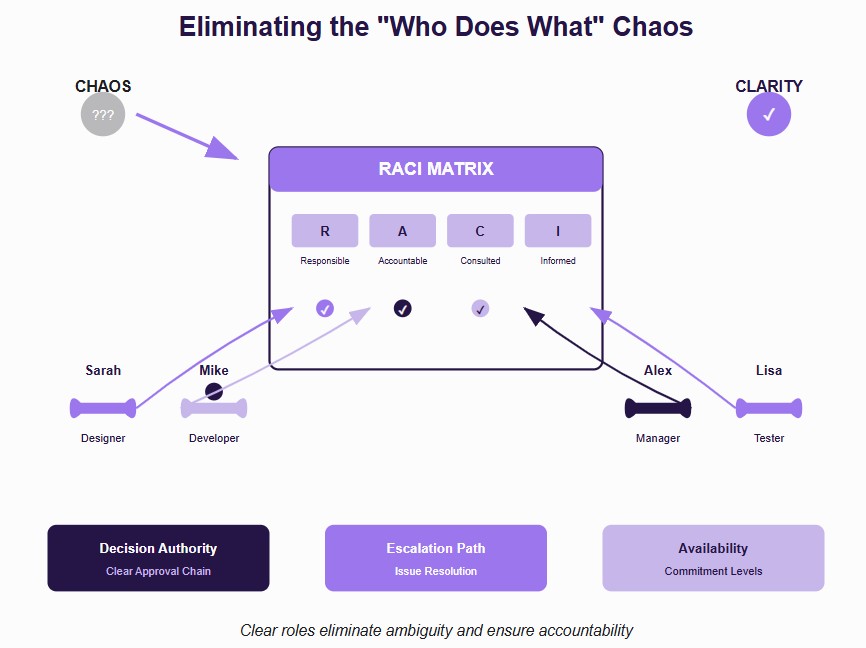
Step 6: Review timeline and dependencies
A timeline without dependencies is just wishful thinking. This step creates realistic expectations about project flow and identifies potential bottlenecks before they become problems.
- Present the project roadmap with all major milestones clearly marked
- Identify critical path activities and key dependencies between tasks
- Discuss potential risks and preliminary mitigation strategies
- Confirm resource availability and any timing constraints
Example Framework: Use the "traffic light" system - a method often integrated into robust IT project management systems to mark dependencies as green (confirmed), yellow (potential issues), or red (definite constraints). This visual approach helps everyone quickly understand where attention is needed.
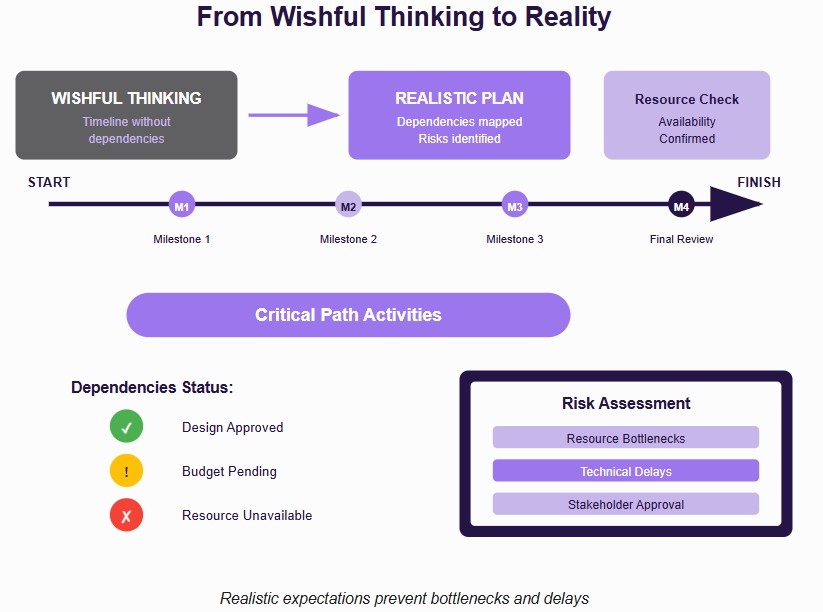
Step 7: Define communication framework
Poor communication is cited as the primary reason for project failure in 57% of unsuccessful projects. Establishing clear communication protocols upfront prevents information gaps and ensures everyone stays informed.
- Establish primary communication channels and when to use each one
- Set regular meeting cadence for status updates and decision-making
- Define reporting requirements, including format, frequency, and recipients
- Create standards for document sharing and collaborative work
Best Practice: Implement the "no surprises" rule—any issue that could impact timeline, budget, or scope must be communicated within 24 hours of discovery. This prevents small problems from becoming project disasters.
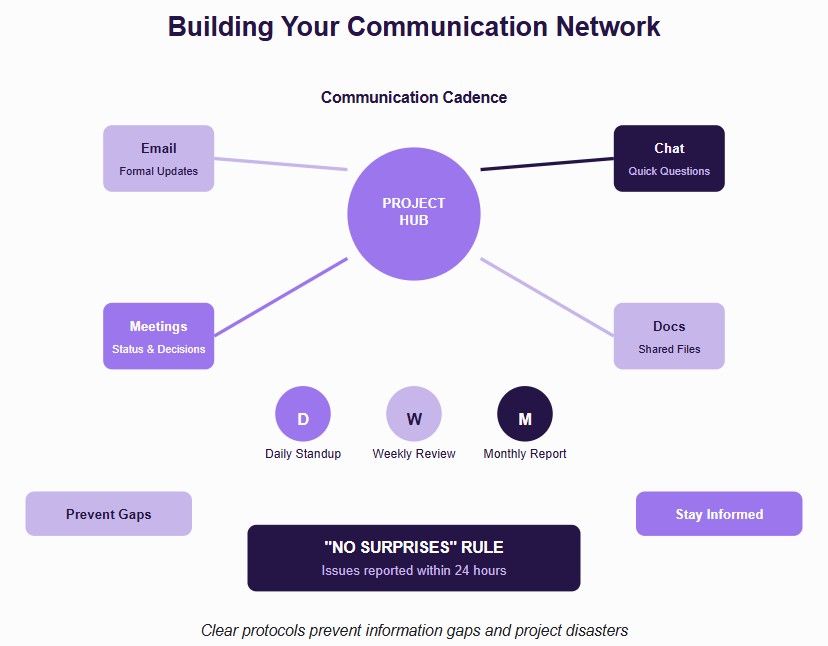
Step 8: Capture next steps and follow-up
A meeting without clear next steps is just an expensive conversation. This final step transforms discussion into action and ensures momentum continues beyond the conference room.
- Document all decisions and commitments made during the meeting
- Assign specific owners and due dates for immediate action items
- Schedule necessary follow-up meetings and working sessions
- Confirm the process for tracking progress and maintaining accountability
Meeting Wrap-Up Template: "Before we adjourn, let's confirm our immediate next steps. [Name], you're completing [action] by [date]. [Name], you're handling [action] by [date]. We'll reconvene on [date] to review progress. Does everyone have what they need to move forward successfully?"
A successful kickoff meeting isn't measured by how smoothly it runs; it's measured by how well it sets up your project for success. When you follow this 8-step framework, you create the foundation for clear communication, aligned expectations, and collaborative success that carries through your entire project lifecycle.
Avoid these project kickoff meeting mistakes (and what to do instead)
Even experienced project managers fall into these critical traps that transform promising projects into chaotic disasters. The good news? Every mistake is completely preventable when you know what to watch for.
Mistake #1: Starting without a crystal-clear scope
Walking into a kickoff meeting with a vague project scope is like building a house without blueprints. Teams make assumptions, stakeholders have different expectations, and scope creep becomes inevitable.
The Fix: Create a detailed scope document 72 hours before your meeting. Include specific deliverables, boundaries, and success criteria. During the kickoff, spend 15 minutes reviewing what's in scope and what's explicitly out of scope. Make "out of scope" a comfortable phrase that everyone uses freely.
Mistake #2: Letting stakeholders hijack your agenda
Picture this: You're 20 minutes into your carefully planned agenda when a stakeholder says, "Before we continue, can we discuss..." Suddenly, your structured meeting becomes an unproductive free-for-all that leaves everyone confused.
The Fix: Establish ground rules at the beginning: "We have specific objectives today. If new topics arise, I'll capture them for follow-up discussions." Use a parking lot method—write down off-topic items on a visible board or document, then address them in scheduled follow-up sessions.
Mistake #3: No alignment on success metrics
When teams don't agree on what success looks like, they're essentially playing different games with different scorecards. This leads to conflicting priorities and disappointing outcomes that could have been avoided.
The Fix: Define SMART success criteria before the meeting and get explicit agreement from all stakeholders. Ask directly: "Does everyone agree that increasing customer satisfaction by 25% within 6 months defines success for this project?" Document the consensus and reference it throughout the project lifecycle.
Mistake #4: Skipping the pre-read package
Showing up to explain basic project information wastes precious meeting time and creates information overload. Attendees struggle to process new information while simultaneously making important decisions.
The Fix: Send a comprehensive pre-read package 48-72 hours in advance. Include the project charter, scope statement, preliminary timeline, and one-page executive summary. Start your meeting by asking: "What questions do you have about the materials?" This approach makes meetings 40% more productive.
Mistake #5: No clear escalation paths
When issues arise (and they always do), teams without defined escalation procedures waste time debating who should make decisions. Projects stall while everyone waits for someone else to take action.
The Fix: Create a decision-making hierarchy during your kickoff. Specify exactly who makes what types of decisions and when issues get escalated. For example: "Budget decisions under $5,000 go to Sarah. Anything above that goes to the steering committee within 24 hours."
Mistake #6: Forgetting to assign meeting roles
Meetings without designated roles often result in poor documentation, missed action items, and confused follow-up. The project manager tries to facilitate, present, and take notes simultaneously, an impossible task.
The Fix: Assign specific roles before the meeting starts: facilitator (guides discussion), note-taker (captures decisions and action items), and timekeeper (keeps agenda on track). Rotate these roles in follow-up meetings to maintain engagement.
Mistake #7: Ending without clear next steps
A meeting that ends with "Great discussion, everyone!" but no concrete action items is just an expensive conversation. Teams leave feeling good but unclear about what happens next.
The Fix: Reserve the final 10 minutes for action item review. Use this template: "Before we adjourn: [Name] will complete [specific action] by [date]. [Name] will handle [specific action] by [date]. We'll reconvene on [date] to review progress. Any questions about next steps?"
The critical 48 hours: Your post-kickoff action plan that seals project success
The real work begins the moment your kickoff meeting ends. How you handle the next 48 hours determines whether your carefully planned alignment transforms into project momentum or slowly fades into confusion and forgotten commitments.

Hour 1-2: Send the follow-up email that works
Most project managers send generic "thanks for attending" emails that get buried in inboxes. Instead, craft a comprehensive summary that becomes the project's single source of truth.
Essential Email Template Components:
- Meeting recap with key decisions highlighted in bold
- Action items with specific owners and due dates
- Next meeting dates and objectives clearly stated
- Key resources and document links organized by priority
Pro Tip: Use the subject line "[Project Name] - Action Required: Your Tasks Inside" to ensure immediate attention. Studies show that action-oriented subject lines get 35% higher open rates than generic summaries.
Hour 3-6: Lock down task assignments (before memory fades)
The longer you wait to clarify task assignments, the more ambiguity creeps in. People remember conversations differently, and what seemed clear in the meeting becomes fuzzy by the next day.
Task Assignment Best Practices:
- Confirm understanding with each task owner individually
- Set specific deliverables rather than vague responsibilities
- Establish check-in dates before the final deadline
- Create backup plans for critical path items
Critical Success Factor: Send a direct message to each task owner asking: "Can you confirm you're comfortable with [specific task] by [date]? Any questions or concerns?" This personal touch prevents surprises later.
Day 1-2: Establish your project command center
Without a centralized information hub, teams quickly become fragmented. Documents get lost, updates scatter across email threads, and collaboration breaks down.
Document Organization Strategy:
- Create a shared folder with clear naming conventions
- Set up version control to prevent document confusion
- Establish access permissions based on team roles
- Define update protocols for shared documents
Recommended Structure:
- 📁 Project Charter & Scope
- 📁 Meeting Notes & Decisions
- 📁 Templates & Resources
- 📁 Weekly Status Reports
Ongoing: Track alignment with smart project management
The best kickoff meetings mean nothing if alignment drifts over time. Use modern project management tools to maintain the clarity you established in your kickoff.
Essential Tracking Elements:
- Weekly pulse checks on project vision alignment
- Monthly stakeholder satisfaction surveys
- Milestone reviews that reference original kickoff decisions
- Regular scope boundary reinforcement
Tool Integration: Connect your kickoff outcomes to platforms like Dart AI, Asana, or ClickUp to create automated reminders and progress tracking that keeps everyone accountable to their original commitments.
Your 48-hour success checklist
- Follow-up email sent within 2 hours
- Task confirmations received from all owners
- Document repository created and shared
- Next meeting scheduled and calendared
- Tracking system activated and tested
- Stakeholder feedback collected and reviewed
Your kickoff meeting is only as good as your follow-through. The teams that consistently deliver successful projects don't just run great kickoffs - they execute flawlessly in the critical hours that follow. This 48-hour window is where project champions separate themselves from project casualties.
Build trust, ownership, and results from the start
A powerful project kickoff isn’t just about getting everyone in the room; it’s about creating shared clarity, defined roles, and forward momentum. When expectations are clear from the start, teams work with purpose, stakeholders stay aligned, and scope stays controlled.
Use this framework to lead with confidence, eliminate confusion, and spark early trust that lasts. Because the strongest projects don’t start with chaos, they start with clarity, commitment, and action.



_light%201.png)





